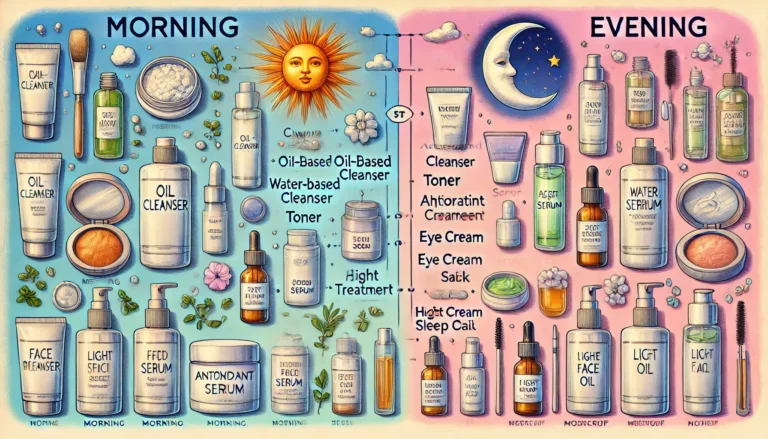Optimize Skincare with Your Skin’s Natural Daily Cycle
Our bodies are finely tuned machines, operating according to an internal clock that regulates numerous biological processes. This internal clock, known as the circadian rhythm, governs everything from our sleep-wake cycles to hormone release and even skin functions. Understanding the circadian rhythm of our skin can be a game-changer in optimizing skincare routines to achieve healthier, more radiant skin.
Most of us focus on the ingredients in our skincare products, but the timing of their application can be just as crucial. By aligning our skincare regimen with the natural cycles of our skin, we can enhance the efficacy of products and promote better skin health. This article delves into the concept of skin’s circadian rhythm, exploring how understanding these natural cycles can help you maximize the benefits of your skincare routine.
While the concept of circadian rhythms is well-established in the realms of sleep and metabolism, its role in skin health is an exciting frontier. Researchers are uncovering how skin’s needs and functions change throughout the day, influencing everything from moisture levels to cell repair processes. Let’s explore how these discoveries can help us refine our approach to skincare.
What is Skin’s Circadian Rhythm?
Just like the rest of your body, your skin operates on a circadian rhythm, which is a roughly 24-hour cycle. This rhythm is driven by a complex interplay of hormones, genetic expression, and environmental factors. During the day, your skin’s primary function is protective, shielding against UV radiation and pollution. At night, the focus shifts to repair and regeneration, as cell turnover increases and DNA repair mechanisms are more active.
This daily cycle means that our skin has different needs at various times. For example, during the day, your skin demands more protection in the form of antioxidants and sunscreen, while at night, it benefits from reparative ingredients like retinoids and peptides. By recognizing these needs, we can tailor our skincare routines to support the skin’s natural processes.
The Science Behind Skin’s Daily Cycle
The circadian rhythm of the skin is regulated by certain genes and proteins that are sensitive to light and darkness. During daylight hours, your skin produces more natural oils to bolster its barrier against environmental stressors. The production of sebum, the skin’s natural oil, peaks in the afternoon, providing a protective layer against pollutants and UV rays.
At night, the absence of light triggers a shift in the skin’s priorities. The skin’s permeability increases, allowing for greater absorption of topical treatments. This is why night creams and serums can be more effective in delivering active ingredients. Additionally, the skin’s temperature rises, boosting blood flow and promoting nutrient delivery to skin cells, further supporting repair and regeneration.
Daytime Skincare: Protection and Prevention
Understanding that your skin is more focused on protection during the day can help you select products that reinforce this function. A good daytime skincare routine should include antioxidants to combat free radicals, which are abundant in sunlight and pollution. Ingredients like vitamin C and E are excellent choices for their ability to neutralize these harmful molecules.
Sunscreen is, without a doubt, the most crucial component of daytime skincare. The consistent use of a broad-spectrum SPF can prevent photoaging and protect against skin cancer. Look for formulations that suit your skin type, whether it’s a lightweight gel for oily skin or a hydrating cream for dry skin.
Optimizing Daytime Skincare
To make the most of your daytime skincare products, apply them in the right order. Typically, you should start with a cleanser to remove impurities, followed by a toner to balance pH levels. Next, apply a serum rich in antioxidants, followed by a moisturizer to lock in hydration. Finish with sunscreen as the last step to ensure comprehensive protection from UV rays.
Nighttime Skincare: Repair and Replenish
At night, when your skin shifts into repair mode, it’s time to focus on treatments that support these restorative processes. This is when you should incorporate products containing retinoids, peptides, and growth factors, which can stimulate collagen production and enhance cell turnover. These ingredients help repair daily damage and slow the signs of aging.
Hydration is also key at night, as the skin loses more water while you sleep. A good nighttime moisturizer can help replenish moisture levels and prevent overnight water loss. Look for products containing hyaluronic acid, which attracts and retains moisture, keeping your skin plump and hydrated.
Crafting Your Nighttime Routine
Begin your evening routine with a gentle cleanser to remove makeup and impurities. Follow with a targeted treatment, such as a retinol or peptide serum, to address specific concerns like wrinkles or hyperpigmentation. Seal in these actives with a nourishing moisturizer. For those with dry skin, consider adding an overnight mask or oil for an extra layer of hydration.
Adapting to Seasonal Changes
As the seasons change, so do the needs of your skin. Circadian rhythms can be influenced by external factors like temperature and humidity, which vary throughout the year. During colder months, your skin may require richer, more emollient products to combat dryness. In contrast, lighter, oil-free formulations might be more suitable for hot, humid weather.
Paying attention to how your skin reacts to seasonal changes can help you adjust your routine accordingly. Transitioning your skincare products with the seasons ensures that your skin remains balanced and healthy, regardless of external conditions.
Maintaining Consistency
While adapting to your skin’s circadian rhythm and seasonal needs is important, consistency remains key to achieving lasting results. Regular application of appropriate products, combined with a balanced lifestyle, can enhance the skin’s natural rhythms and promote long-term skin health. Listen to your skin’s signals and be patient; it takes time for routines to show results.
Understanding and working with your skin’s circadian rhythm can transform your skincare approach, making it more effective and aligned with your body’s natural processes. By fine-tuning your routine to meet your skin’s changing needs throughout the day and year, you can achieve a clearer, more youthful complexion. Embrace the rhythm, and let your skin thrive.



